Optiwise receives funding from the Horizon Europe research programme under grant agreement No. 101056769.
Image: Chantiers de l'Atlantique
“These model tests will allow us to confirm the good performance of a cruise vessel equipped with our technology SolidSail. This performance relates to different aspects such as comfort level in waves, manoeuvring performance – including course keeping, speed performance under sails and optimal use of the sails in combination with the ship dynamics during operation. Additionally, we can explore the operational limits for the use of the sails.”

Chloé Duport,
Aerodynamic Engineer, Chantiers de l’ Atlantique
Publications:

BlueLabs
MARIN recently got awarded the “BlueLabs” project. This will allow MARIN to upgrade its modelling and measurement capabilities regarding:
Real wind generation for floating wind applications
Modelling wind forces and onboard systems using advanced actuators (winches)
Model tests without any wires attached
Optical measurements of motions and deformations
As part of item 2, the dynamic winch system for the application of wind propulsion and manoeuvring and seakeeping will be made more robust and standardised. The setup developed in Optiwise is used as a template.
March 2024, no. 139








Create a MARIN account to stay updated




marin.nl/jips/optiwise
The market introduction of wind propulsion continues to accelerate with the fleet of commercial ships equipped doubling in the last year.
And if you follow LinkedIn or the news, the number of announcements regarding new projects, but also indeed actual installations, does not show any sign of slowing down. So, it seems that wind propulsion is eventually being recognised as a major tool to decarbonise shipping and limit the dependence on alternative fuels.
Most installations are relatively modest, targeting energy savings of some 5% to 15%, which is already very useful and generally impossible to achieve with other means, except for slowing down. Such installations can mostly be implemented in a “business as usual scenario”. Only minor changes are needed to the ship, and its operations can remain the same as before.




More info
Report
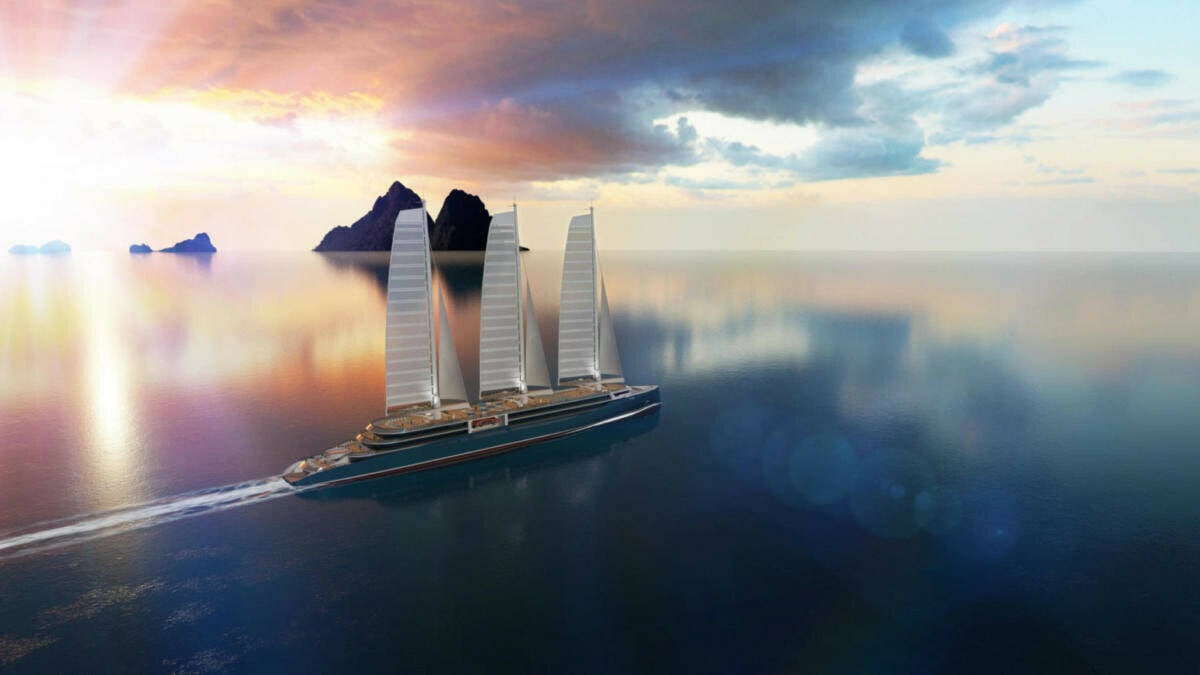
Image: Chantiers de l'Atlantique
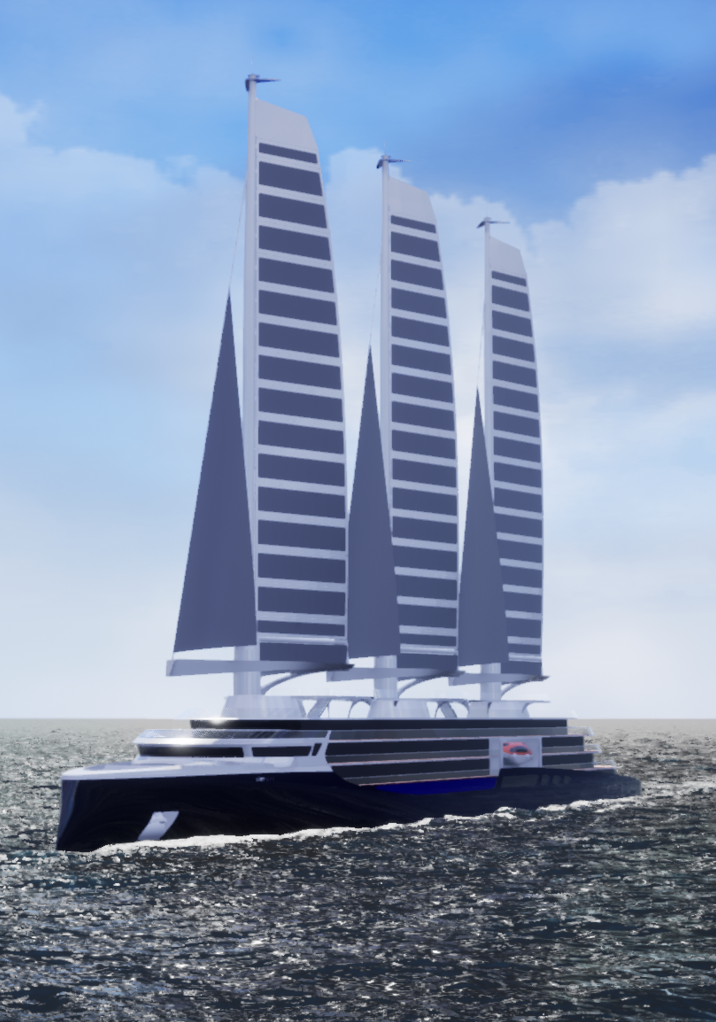
Silentseas, a sail-powered hybrid ship concept.
Figure 1 shows the new test setup. The ship model is equipped with a mast, which allows the centre of effort (between tests) to be adjusted. The mast is equipped with a fixed reel and a bearing to which five lines from five winches are attached. Using these winches we can apply forces in any direction. Forces can be measured between the mast and the model, making it possible to verify that the total force is applied correctly.
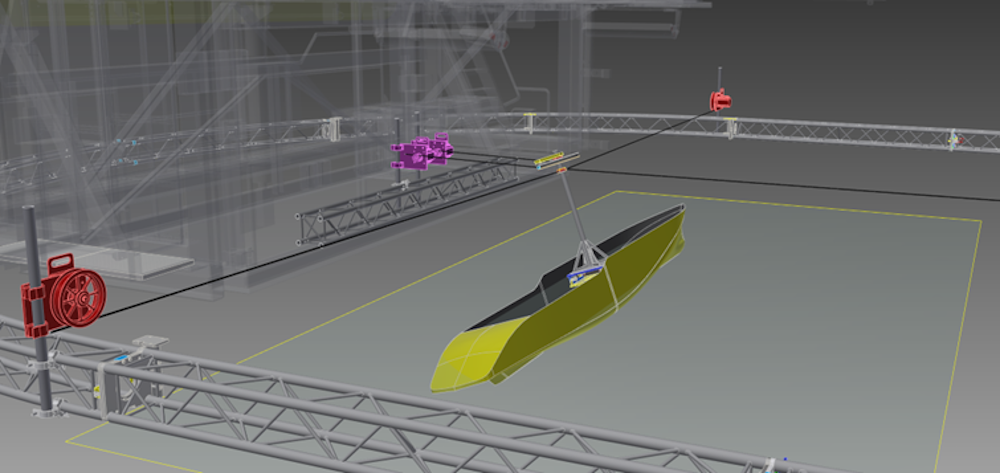
Various tests were done with the winch lines attached and controlled such that there is a small pre-tension in each line to prevent the lines becoming too loose. While pre-tensioning each line, the overall net force applied on the model must be equal to zero (the line loads needed to cancel each other). In theory, the result should be identical to doing the same test without any lines attached. We have noted that for low roll periods, the system adds some unwanted damping and inertia. For other tests, such as course keeping, zigzag and turning circles, deviations were minimal. This indicates that the bearing on the mast, which will always introduce some yaw damping, has only minimal impact on the overall test result.
Using the tests, the performance of the Chantiers de l’ Atlantique design concept was explored. Although detailed analysis is still ongoing, the results already show that, within operational limits for the wind propulsion, the ship did not show any trouble in course keeping, even when sailing fully on wind propulsion. Turning circles were done according to IMO definitions while sailing. This is a very conservative approach as the IMO requirements are really only intended for motor-driven vessels. As expected, the test results are not easy to interpret. This will feed into discussions on what could be better manoeuvring requirements for such ships.
The test results will be further processed in design assessments in the Optiwise project, complementing them with simulations, and will feature in upcoming scientific publications.
Collaboration
The Optiwise Horizon Europe project is proving to be a great opportunity for collaboration. We are able to prepare ourselves for the further implementation of wind propulsion taking into account the roles of research institute and shipyard.
Prototype – practical experience
Using this setup, the cruise vessel concept of Chantiers de l’ Atlantique was tested at the end of 2023 (see video). The tests proved very valuable to check the performance of the setup both in terms of practical implementation and modelling the physics.
After the initial work to get this new setup working, final tests are proving really straightforward to conduct. It is a matter of inserting wind conditions and the wind propulsion control for each test, which is just a few clicks in a graphical interface. Then tests can be started as normal.
Selection of method to apply aerodynamic loads
Based on previous work using both simulations and model testing, we know that wind propulsion can affect seakeeping and manoeuvring. We have applied aerodynamic forces in experiments; the methods that we worked with included dynamic winches and installing a simplified wind tunnel in the facility, allowing a ship to sail in “real” wind. Colleague institutes have also used wind fans. When using these, it is not the wind that they are after, they actually use the reaction forces of the wind fans themselves to mimic the wind propulsion. Within Optiwise, we wanted and needed to make a clear choice for the future. Wind quality and scale effects have proven troublesome in the approach with a simplified wind tunnel. Therefore, we chose winches rather than wind fans and winches, as much larger forces can be applied. This allows fast response times, with only a little addition of weight and cables and no increased power requirement for the ship model. Moreover, the large number of wind fans that would be required would generate a noise level that we were not willing to accept.
Optiwise project
In 2022, MARIN together with several partners, started the EU-funded Optiwise project specifically to develop, design and assess methods for those ships powered substantially by wind propulsion. And we demonstrate these methods in three cases. One of them considers a cruise ship design by Chantiers de l’Atlantique, that is also the developer of the Silenseas project. As part of the project, we set out to develop a test setup in our Seakeeping and Manoeuvring Basin which allows us to model the aerodynamic loads while doing free running manoeuvring and seakeeping tests.
However, we now also see an increase in projects with far greater ambitions. For instance, the projects Neoliner, Oceanbird and Silenseas target savings well beyond 50%, effectively making wind the main propulsion and the propeller provides assistance. For such projects we need to reconsider the design and operations. To ensure satisfactory behaviour and maximum efficiency, it is not sufficient to consider wind propulsion as an add-on. Both operations and design need to be considered, taking into account the wind propulsion system. And that includes manoeuvring and seakeeping, which happens to be a common topic for testing at MARIN.



Figure 2: Simulation in the Loop (SiL)
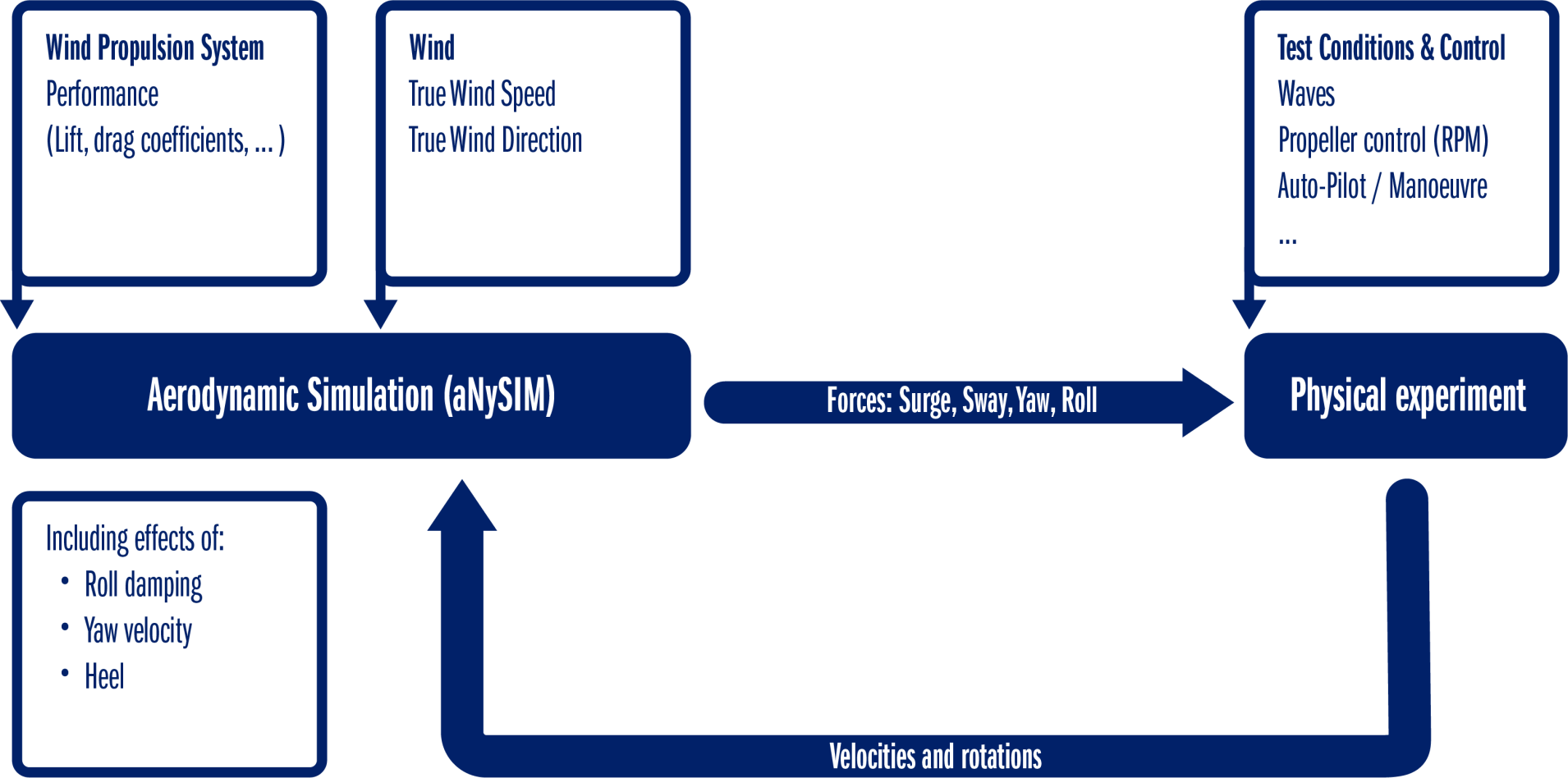
Aerodynamic loads are calculated in parallel to the experiment, as shown in Figure 2. The simulation takes into account:
Performance modelling of the wind propulsion system
Specified wind conditions (which may be variable)
Instantaneous velocities and rotations of the model in the basin
Elaboration of test setup
We developed a test setup, extending on the capabilities of previous projects at MARIN. This consisted of the following:
Forces are applied in a surge and sway direction and moments are subjected in a roll and yaw direction. The roll moment is linked to the force applied in sway by adjusting the connection point height. The other force and moment directions are defined independently.
Forces are adjusted continuously due to effective apparent wind at the locations of wind propulsion devices, dependent on ship speed, heading, heel, drift, yaw rate, and the defined wind condition, which may be variable (e.g. modelling gusts).
Aerodynamic interaction between device and ship and between individual devices is modelled.
Roll damping is included through a correction of apparent wind due to roll velocity at the centre of effort of each device.
Control of wind propulsion systems is included. For instance, the wind propulsion can be modelled to be powered down once a manoeuvre starts, or to actually generate forces to assist in steering the ship.
Not only the aerodynamic forces of wind propulsion can be modelled. Additionally, the superstructure wind loads and a correction on the resistance at model scale can be implemented.
The setup has the ability to perform arbitrary manoeuvres, including turning circles.
“Using the case provided by Chantiers de l’ Atlantique, we developed an improved test setup for manoeuvring and seakeeping with wind propulsion, which we can now use to demonstrate that ships with substantial wind propulsion are not only efficient on energy, but also safe, compliant to rules and comfortable.”

Anton Kisjes,
Project Manager, MARIN
Optiwise, the EU-funded project to develop, design and assess methods for ships powered substantially by wind propulsion
Publications:

BlueLabs
MARIN recently got awarded the “BlueLabs” project. This will allow MARIN to upgrade its modelling and measurement capabilities regarding:
Real wind generation for floating wind applications
Modelling wind forces and onboard systems using advanced actuators (winches)
Model tests without any wires attached
Optical measurements of motions and deformations
As part of item 2, the dynamic winch system for the application of wind propulsion and manoeuvring and seakeeping will be made more robust and standardised. The setup developed in Optiwise is used as a template.

Optiwise receives funding from the Horizon Europe research programme under grant agreement No. 101056769.


marin.nl/jips/optiwise
More info
“These model tests will allow us to confirm the good performance of a cruise vessel equipped with our technology SolidSail. This performance relates to different aspects such as comfort level in waves, manoeuvring performance – including course keeping, speed performance under sails and optimal use of the sails in combination with the ship dynamics during operation. Additionally, we can explore the operational limits for the use of the sails.”

Chloé Duport,
Aerodynamic Engineer, Chantiers de l’ Atlantique
Optiwise, the EU-funded project to develop, design and assess methods for ships powered substantially by wind propulsion
“Using the case provided by Chantiers de l’ Atlantique, we developed an improved test setup for manoeuvring and seakeeping with wind propulsion, which we can now use to demonstrate that ships with substantial wind propulsion are not only efficient on energy, but also safe, compliant to rules and comfortable.”

Anton Kisjes,
Project Manager, MARIN
Various tests were done with the winch lines attached and controlled such that there is a small pre-tension in each line to prevent the lines becoming too loose. While pre-tensioning each line, the overall net force applied on the model must be equal to zero (the line loads needed to cancel each other). In theory, the result should be identical to doing the same test without any lines attached. We have noted that for low roll periods, the system adds some unwanted damping and inertia. For other tests, such as course keeping, zigzag and turning circles, deviations were minimal. This indicates that the bearing on the mast, which will always introduce some yaw damping, has only minimal impact on the overall test result.
Using the tests, the performance of the Chantiers de l’ Atlantique design concept was explored. Although detailed analysis is still ongoing, the results already show that, within operational limits for the wind propulsion, the ship did not show any trouble in course keeping, even when sailing fully on wind propulsion. Turning circles were done according to IMO definitions while sailing. This is a very conservative approach as the IMO requirements are really only intended for motor-driven vessels. As expected, the test results are not easy to interpret. This will feed into discussions on what could be better manoeuvring requirements for such ships.
The test results will be further processed in design assessments in the Optiwise project, complementing them with simulations, and will feature in upcoming scientific publications.
Collaboration
The Optiwise Horizon Europe project is proving to be a great opportunity for collaboration. We are able to prepare ourselves for the further implementation of wind propulsion taking into account the roles of research institute and shipyard.
Prototype – practical experience
Using this setup, the cruise vessel concept of Chantiers de l’ Atlantique was tested at the end of 2023 (see video). The tests proved very valuable to check the performance of the setup both in terms of practical implementation and modelling the physics.
After the initial work to get this new setup working, final tests are proving really straightforward to conduct. It is a matter of inserting wind conditions and the wind propulsion control for each test, which is just a few clicks in a graphical interface. Then tests can be started as normal.
Figure 2: Simulation in the Loop (SiL)
Figure 1 shows the new test setup. The ship model is equipped with a mast, which allows the centre of effort (between tests) to be adjusted. The mast is equipped with a fixed reel and a bearing to which five lines from five winches are attached. Using these winches we can apply forces in any direction. Forces can be measured between the mast and the model, making it possible to verify that the total force is applied correctly.
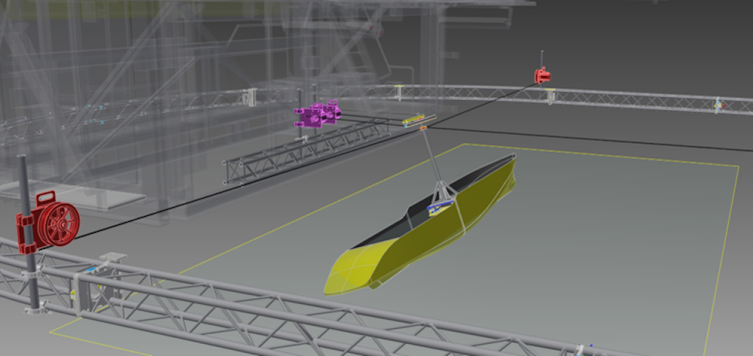
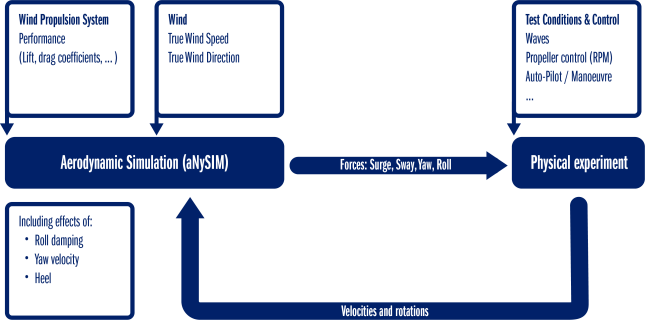
Aerodynamic loads are calculated in parallel to the experiment, as shown in Figure 2. The simulation takes into account:
Performance modelling of the wind propulsion system
Specified wind conditions (which may be variable)
Instantaneous velocities and rotations of the model in the basin
Selection of method to apply aerodynamic loads
Based on previous work using both simulations and model testing, we know that wind propulsion can affect seakeeping and manoeuvring. We have applied aerodynamic forces in experiments; the methods that we worked with included dynamic winches and installing a simplified wind tunnel in the facility, allowing a ship to sail in “real” wind. Colleague institutes have also used wind fans. When using these, it is not the wind that they are after, they actually use the reaction forces of the wind fans themselves to mimic the wind propulsion. Within Optiwise, we wanted and needed to make a clear choice for the future. Wind quality and scale effects have proven troublesome in the approach with a simplified wind tunnel. Therefore, we chose winches rather than wind fans and winches, as much larger forces can be applied. This allows fast response times, with only a little addition of weight and cables and no increased power requirement for the ship model. Moreover, the large number of wind fans that would be required would generate a noise level that we were not willing to accept.
Elaboration of test setup
We developed a test setup, extending on the capabilities of previous projects at MARIN. This consisted of the following:
Forces are applied in a surge and sway direction and moments are subjected in a roll and yaw direction. The roll moment is linked to the force applied in sway by adjusting the connection point height. The other force and moment directions are defined independently.
Forces are adjusted continuously due to effective apparent wind at the locations of wind propulsion devices, dependent on ship speed, heading, heel, drift, yaw rate, and the defined wind condition, which may be variable (e.g. modelling gusts).
Aerodynamic interaction between device and ship and between individual devices is modelled.
Roll damping is included through a correction of apparent wind due to roll velocity at the centre of effort of each device.
Control of wind propulsion systems is included. For instance, the wind propulsion can be modelled to be powered down once a manoeuvre starts, or to actually generate forces to assist in steering the ship.
Not only the aerodynamic forces of wind propulsion can be modelled. Additionally, the superstructure wind loads and a correction on the resistance at model scale can be implemented.
The setup has the ability to perform arbitrary manoeuvres, including turning circles.
Optiwise project
In 2022, MARIN together with several partners, started the EU-funded Optiwise project specifically to develop, design and assess methods for those ships powered substantially by wind propulsion. And we demonstrate these methods in three cases. One of them considers a cruise ship design by Chantiers de l’Atlantique, that is also the developer of the Silenseas project. As part of the project, we set out to develop a test setup in our Seakeeping and Manoeuvring Basin which allows us to model the aerodynamic loads while doing free running manoeuvring and seakeeping tests.
Image: Chantiers de l'Atlantique
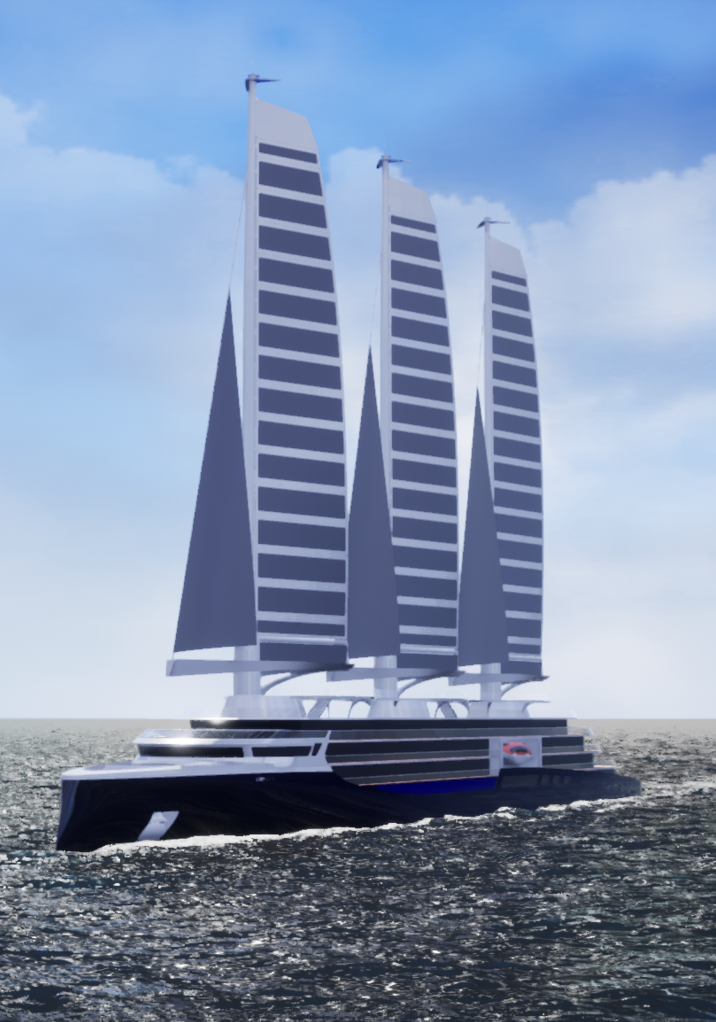
Silentseas, a sail-powered hybrid ship concept.
However, we now also see an increase in projects with far greater ambitions. For instance, the projects Neoliner, Oceanbird and Silenseas target savings well beyond 50%, effectively making wind the main propulsion and the propeller provides assistance. For such projects we need to reconsider the design and operations. To ensure satisfactory behaviour and maximum efficiency, it is not sufficient to consider wind propulsion as an add-on. Both operations and design need to be considered, taking into account the wind propulsion system. And that includes manoeuvring and seakeeping, which happens to be a common topic for testing at MARIN.
Image: Chantiers de l'Atlantique
March 2024, no. 139
Create a MARIN account to stay updated





Report
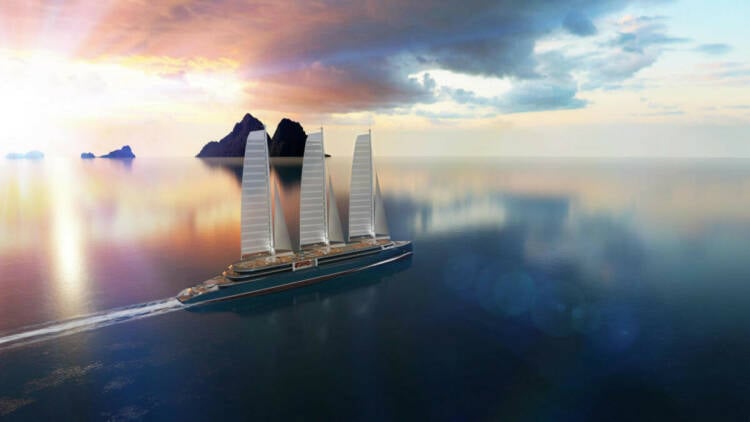
And if you follow LinkedIn or the news, the number of announcements regarding new projects, but also indeed actual installations, does not show any sign of slowing down. So, it seems that wind propulsion is eventually being recognised as a major tool to decarbonise shipping and limit the dependence on alternative fuels.
Most installations are relatively modest, targeting energy savings of some 5% to 15%, which is already very useful and generally impossible to achieve with other means, except for slowing down. Such installations can mostly be implemented in a “business as usual scenario”. Only minor changes are needed to the ship, and its operations can remain the same as before.
The market introduction of wind propulsion continues to accelerate with the fleet of commercial ships equipped doubling in the last year.







